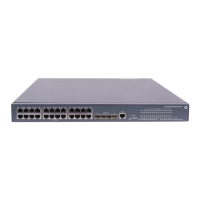136
Ste
Command
Remarks
5. Enter interface view or
port group view.
• Enter Layer 2 Ethernet interface
view:
interface interface-type
interface-number
• Enter Layer 2 aggregate
interface view:
interface bridge-aggregation
interface-number
• Enter port group view:
port-group manual
port-group-name
Use any command.
• The configuration made in Ethernet
interface view applies only to the port.
• The configuration made in port group
view applies to all ports in the port
group.
• The configuration made in Layer 2
aggregate interface view applies to
the aggregate interface and its
aggregation member ports. If the
system fails to apply the configuration
to the aggregate interface, it stops
applying the configuration to
aggregation member ports. If the
system fails to apply the configuration
to an aggregation member port, it
skips the port and moves to the next
member port.
6. Configure port link
type as hybrid.
port link-type hybrid By default, all ports are access ports.
7. Configure the hybrid
ports to permit the
specified IP
subnet-based VLANs
to pass through.
port hybrid vlan vlan-list { tagged |
untagged }
By default, a hybrid port allows only
packets from VLAN 1 to pass through
untagged.
8. Associate the hybrid
ports with the specified
IP subnet-based VLAN.
port hybrid ip-subnet-vlan vlan
vlan-id
Not configured by default.
IP subnet-based VLAN configuration example
Network requirements
As shown in Figure 44, the hosts in the office belong to different IP subnets 192.168.5.0/24 and
192.168.50.0/24.
Configure Device C to transmit packets over separate VLANs based on their source IP addresses.
Figure 44 Network diagram

